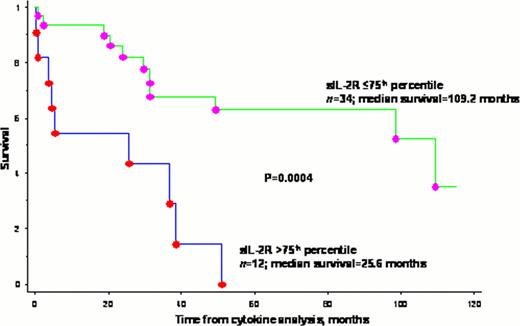Abstract
Abstract 2836
The clinical phenotype of systemic mastocytosis (SM) is highly variable; establishing prognosis in terms of overall survival or risk of transformation to aggressive disease for those with non-indolent and indolent disease variants, respectively, is not trivial. Similar to other clonal hemopathies, mast cell (MC) activation and/or stromal response to clonal MC expansion likely results in a dysregulated immuno cellular/cytokine profile; analysis of this aspect of SM may provide additional prognostic information within the context of well established parameters such as the World Health Organization (WHO) SM classification system. Here, we conducted a comprehensive analysis of circulating cytokines/chemokines with clinicopathologic and clinical outcome correlations in a cohort of SM patients seen at our institution.
The diagnosis of SM and its subclassification were established according to WHO criteria. Inclusion in this study required availability of archived plasma, bone marrow biopsy, and cytogenetic information at the time of first referral. Follow up information including data on survival and disease progression were updated in July 2012. Concentrations of plasma cytokines were analyzed in duplicate by using Multiplex Bead-Based Luminex technology (Invitrogen, Carlsbad, CA).
Forty six SM patients met the above stipulated criteria; 25 (54%) were male and the median age at referral was 61 years (range 21–85). Subclassification of patients per WHO criteria was: indolent SM (ISM) 23 (50%), aggressive SM (ASM) 8 (17%) and SM with associated clonal hematological non-MC lineage disease (SM-AHNMD) 15 (33%).
When the distribution of 30 cytokines was considered across the 3 SM sub groups, only interleukin (IL)-8 was significantly different (SM-AHNMD > ISM/ASM; p=0.0002). For ISM patients, increased levels of sIL-2R were associated with presence of B-findings (p=0.0046) including splenomegaly (p=0.001) and serum tryptase levels >200 ng/mL (p=0.0046), and decreased levels of IL-8 and hepatocyte growth factor (HGF) with MC mediator-release symptoms (p <0.05). Increased levels of sIL-2R (r2=0.6; p<0.0001) and RANTES (r2=0.37; p=0.0013) were correlated with bone marrow MC burden, and sIL-2R (r2=0.34; p=0.004) and MIG (r2=0.42; p=0.0012) with serum tryptase levels in ISM patients; similar findings were noted for the overall cohort.
At a median follow up of 28 months (range 0–116), 20 (43%) deaths, and 3 (13%) and 1 (2%) transformations to ASM and mast cell leukemia, respectively, were recorded for the overall cohort. In univariate analysis, increased sIL-2R levels were predictive for inferior overall survival (p=0.005); this prognostic significance was maintained in multivariate analysis after adjusting for other known prognostic variables individually (i.e. WHO SM subtypes, age >65 years, hemoglobin <10 g/dL, thrombocytopenia, weight loss or hypoalbuminemia) (all p <0.05). Increased sIL-2R (>75th percentile) effectively stratified patients in the overall cohort into 2 well-delineated risk groups for overall survival (median survival 109 vs. 26 months; p=0.0004) (Figure). This sIL-2R threshold was also able to risk stratify patients within ISM (median survival not reached vs. 38 months) and non-ISM (median survival 31 vs. 5 months) categories (p <0.0001).
The current study demonstrates s-IL2R to be a key inflammatory cytokine in SM; it is significantly correlated with a phenotype of high systemic MC burden and in this regard, is an attractive surrogate for treatment response in clinical practice, if validated. The predictive value of sIL-2R for overall survival is akin to similar observations in primary myelofibrosis and diffuse large B-cell lymphoma; in this study, it was noted to be independent of conventional measures of organopathy from MC infiltration, and thus may reflect a novel pathogenetic process in SM, mediated by dysregulated inflammatory and/or immuno cellular pathways.
No relevant conflicts of interest to declare.
Author notes
Asterisk with author names denotes non-ASH members.


This feature is available to Subscribers Only
Sign In or Create an Account Close Modal